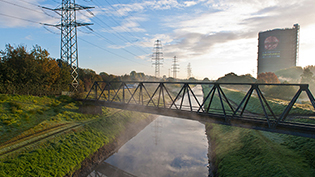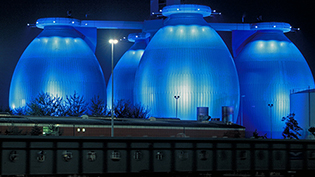IT Security for Critical Infrastructure at EGLV
Flood protection and wastewater management require high-tech solutions. AUVESY-MDT simplifies the management of data for municipal companies and water associations. In addition, the system helps to meet the requirements of the IT Security Act regarding data protection for ICS systems.

The Initial Situation
The German partner water association Emschergenossenschaft und Lippeverband (EGLV) is a network of 59 wastewater treatment plants, 344 pumping stations, 411 wastewater/stormwater treatment facilities, and flood control reservoirs connected by a sophisticated remote control system. The EGLV faces a number of challenges: the ongoing multi-generational Emscher System Exposure project requires the construction of new sewers and the modernization of existing facilities.
EGLV's existing automation and IT infrastructure is heterogeneous and has evolved over decades. This results in a fragmented landscape that makes it difficult to efficiently operate and maintain the facilities. In addition, water utilities such as EGLV are subject to the stringent requirements of the IT Security Act for Critical Infrastructures. Ensuring IT security and rapid recovery in the event of an outage are therefore critical.

In our daily business we appreciate the "Apple Effect": Maintenance personnel on-site can take one look at the software and start using it straight away!

The Solution
EGLV has chosen the AUVESY-MDT solution to ensure optimal maintenance of its installations and to comply with the requirements of the IT security act. This software enables the comprehensive management and security of all automation devices and components. By integrating more than 3,500 projects and approximately 5,000 components into the AUVESY-MDT solution, EGLV has created a centralized and unified platform for managing its facilities. The software allows detailed recording and documentation of all components, including their parameters and settings.
A key aspect of the solution is the flexibility to work with different components. "With the AUVESY-MDT solution, we identify the error or the starting point of a program problem within minutes - in most cases," says Ralf Hellmann. Even components without a direct interface to the software can be managed efficiently with features such as the comparator (SmartCompare). This feature allows the tracking of changes to components and the comparison of versions, thus enabling precise control of the condition of the systems.
AUVESY-MDT also facilitates collaboration with external service providers. The Supplier Check-Out/Check-In function ensures traceability of all changes made by external companies, contributing to security and quality assurance. This is particularly important as EGLV regularly relies on external service providers, especially for larger projects and orders.

The Result
The implementation of the AUVESY-MDT solution has led to a number of significant improvements that have had a profound impact on the efficiency and safety of EGLV's plant management. One of the most outstanding improvements is the regular backup of all digital components, including parameter lists and complete PLC programs.
For interconnected plants, approximately 120 snapshots are taken daily to ensure reliable backup of all relevant data. This comprehensive backup strategy helps minimize potential risks and enables rapid recovery in the event of a failure.
By centrally managing and securing all automation devices and components, EGLV has improved its oversight of its assets and can identify and address potential risks early. "Overall, the cooperation with AUVESY-MDT has proven to be extremely successful. The solution provides exactly the functionalities we need to operate our facilities efficiently and safely," says Ralf Hellmann.
Currently, about 150 users from different departments of the EGLV use the AUVESY-MDT software. This enables a comprehensive use of the solution within EGLV and promotes the cooperation between different departments.
The EGLV now has a powerful platform for the efficient operation of its facilities, for support and for fulfilling the requirements of the IT Security Act.
Contact us
Want to learn more about automatic backups, versioning and documentation in automated production?
Contact us
